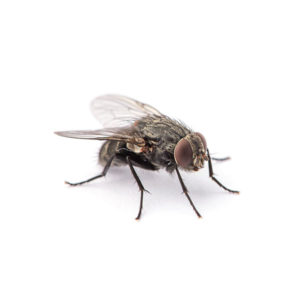Also known as house flies, garbage flies can be easily identified by the four long stripes on top of their middle body region. They do not have the ability to bite and instead have a mouth more suited for sponging up liquid food. Female flies are typically larger than the male and have a visibly wider distance between their red-colored eyes. Garbage flies have gray and slightly yellow bodies as well as an upward bend in one of the wing veins. Garbage flies, often synonymous with filth and decay, are not merely a nuisance but a significant concern due to their potential to spread diseases. These pests are attracted to waste and decaying organic material, making them unwelcome visitors in homes, businesses, and anywhere food waste is present.
Unsure on the type of fly you are dealing with? Take a look at the most common flies found in North Carolina to help identify the specific fly species.
Garbage Fly Identification
What Do Garbage Flies Look Like?
Garbage flies, or filth flies, are typically small to medium in size, with a length ranging from 1/8 to 1/4 inch. They possess a dark, mottled pattern on their wings and bodies that can vary from gray to black. Their eyes are usually bright red or dark, and they have six legs and a pair of antennae, characteristic of most fly species. Their most distinguishing behavior is their constant buzzing around waste and organic decay, making them easy to identify in affected areas.
Signs of a Garbage Fly Infestation
Recognizing the signs of an infestation early can help prevent a larger problem. Key indicators include:
- Frequent sightings of flies around garbage areas, compost bins, or decaying material.
- The presence of larvae or maggots in waste containers, indicating active breeding.
- Adult flies that are seen resting on surfaces near potential food sources during the day.
Habitat, Diet, Lifecycle & Bites
Where Do Garbage Flies Live?
Garbage flies, also known as house flies, inhabit a wide range of environments where decaying organic matter is plentiful. This includes garbage bins, compost piles, and sewage areas. They thrive in moist conditions, where they can breed and feed, making poorly managed waste disposal sites particularly attractive for their proliferation. Generally, garbage flies are most abundant during the warmer summer months. Their eggs are laid in warm, moist organic materials such as manure, garbage, lawn clippings, decaying fruits and vegetables, or soils contaminated with such materials.
Under optimal summertime conditions, house flies can complete their development from egg to adult in as little as 7 days. Therefore, whether it’s in outdoor waste bins or indoor compost heaps, garbage flies are adaptable insects capable of thriving wherever organic decomposition occurs.
Diet of a Garbage Fly
The primary diet of garbage fly larvae consists of decomposing organic matter, which provides the necessary nutrients for their growth. Adults are less dependent on solid waste but are attracted to fermenting or rotting food, where they also lay their eggs.
Life Cycle of a Garbage Fly
The life cycle of garbage flies is rapid, allowing for quick population growth. Females lay eggs in moist, decaying matter, which hatch into larvae (maggots) that feed on the surrounding organic material. Within a week, these larvae can pupate and transform into adult flies, ready to reproduce and continue the cycle. This fast life cycle necessitates swift action to prevent infestations from escalating.
Garbage Fly Bites
Garbage flies do not bite humans. However, their potential to spread diseases through contact with contaminated surfaces or food makes them a public health concern.
Are Garbage Flies Dangerous?
While garbage flies themselves do not cause direct harm through bites or stings, their danger lies in their ability to act as vectors for pathogens. By moving between waste and human environments, they can contaminate food surfaces with bacteria and viruses, including E. coli and Salmonella, leading to foodborne illnesses.
How to Get Rid of Garbage Flies?
Controlling garbage fly populations involves a combination of sanitation, physical barriers, and, if necessary, chemical interventions.
- Improve Sanitation: The cornerstone of garbage fly management is maintaining clean waste disposal areas. Regularly removing trash, cleaning bins, and ensuring that waste is properly contained can significantly reduce attractants.
- Physical Barriers: Use screens on windows and doors to prevent adult flies from entering buildings. Seal cracks and crevices where flies can enter or lay eggs.
- Use of Insecticides: Insecticidal sprays can be effective in reducing adult fly populations when used according to safety guidelines. However, reliance on chemical controls alone is not a sustainable solution and should be part of an integrated pest management approach.
If you are dealing with a persistent garbage fly problem on your property, contact your local fly exterminators.
Garbage Fly Prevention Tips
Prevention is the most effective strategy against garbage flies.
- Regular Waste Management: Ensure that garbage is collected regularly and that bins are sealed and cleaned to prevent odors and residue.
- Compost Carefully: If you compost, do so in a sealed container and turn the pile regularly to speed up decomposition and reduce odors.
- Reduce Moisture: Eliminate standing water and fix leaky faucets or pipes to discourage breeding sites.
Need help with Garbage Flies control?
FAQs
What Causes Garbage Flies?
Garbage flies are attracted to and breed in decaying organic matter. Poor sanitation, unsecured trash, and composting practices can all contribute to infestations.
How Do You Get Rid of Filth Flies?
Eliminating filth flies involves cleaning and sanitizing affected areas, using traps or insecticides to target adult flies, and preventing access to breeding sites through physical barriers and improved waste management.
Why Do I Suddenly Have a Lot of Flies in My House?
A sudden increase in flies typically indicates an available breeding site or food source, such as an overlooked garbage area, decaying organic material, or even a dead animal within the premises.





